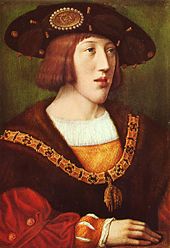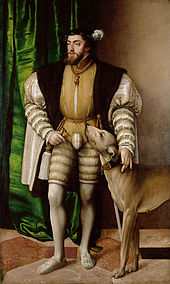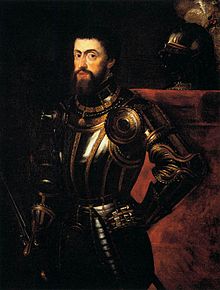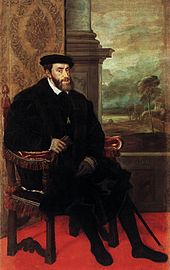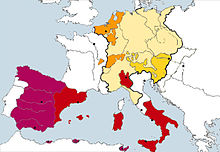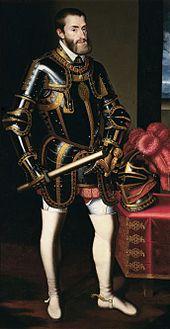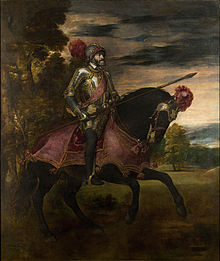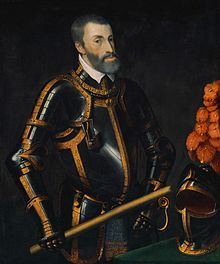
Charles V, Holy Roman Emperor
About this schools Wikipedia selection
SOS Children have produced a selection of wikipedia articles for schools since 2005. Click here for more information on SOS Children.
| Charles V | |
|---|---|
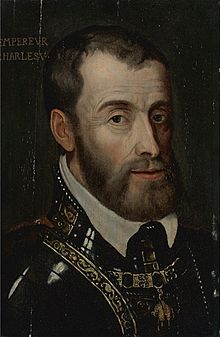 |
|
| Portrait of the Emperor, after Titian | |
|
King of the Romans; King of Italy |
|
| Reign | 28 June 1519 – 27 August 1556 |
| Coronation | 26 October 1520, Aachen (German royal) 22 February 1530, Bologna (Italian royal) 24 February 1530, Bologna (imperial) |
| Predecessor | Maximilian I |
| Successor | Ferdinand I |
|
with Joanna the Mad to 1555 |
|
| Reign | 23 January 1516 – 16 January 1556 |
| Predecessor | Joanna |
| Successor | Philip II |
|
|
|
| Reign | 25 September 1506 – 25 October 1555 |
| Predecessor | Philip I of Castile |
| Successor | Philip II of Spain |
| Spouse | Isabella of Portugal |
| Issue | |
| Philip II, King of Spain Maria, Holy Roman Empress Joanna, Princess of Portugal John of Austria ( illegitimate) Margaret, Duchess of Florence and Parma ( illegitimate) |
|
| House | House of Habsburg |
| Father | Philip I of Castile |
| Mother | Joanna of Castile |
| Born | 24 February 1500 Ghent, Flanders |
| Died | 21 September 1558 (aged 58) Yuste, Spain |
| Burial | El Escorial, San Lorenzo de El Escorial, Spain |
| Signature |  |
| Religion | Roman Catholicism |
Charles V (Spanish: Carlos I; Dutch: Karel V; German: Karl V.; Italian: Carlo V; French: Charles Quint; 24 February 1500 – 21 September 1558) was ruler of the Holy Roman Empire from 1519 and, as Charles I, of the Spanish Empire from 1516 until his voluntary retirement and abdication in favour of his younger brother Ferdinand I as Holy Roman Emperor and his son Philip II as King of Spain in 1556.
Charles was the eldest son of Philip the Handsome and Joanna the Mad. His grandmother was Isabella I of Castile. As the heir of three of Europe's leading dynasties—the House of Habsburg of the Habsburg Monarchy; the House of Valois-Burgundy of the Burgundian Netherlands; and the House of Trastámara of the Crowns of Castile and Aragon—he ruled over extensive domains in Central, Western, and Southern Europe; and the Spanish colonies in the Americas and Asia. As Charles was the first king to rule Castile, León, and Aragon simultaneously in his own right, he became the first King of Spain. In 1519, Charles became Holy Roman Emperor and Archduke of Austria. From that point forward, his empire spanned nearly four million square kilometers across Europe, the Far East, and the Americas.
Much of Charles' reign was devoted to the Italian Wars against France which, although enormously expensive, were militarily successful. Charles' forces re-captured both Milan and Franche-Comté from France after the decisive Habsburg victory at the Battle of Pavia in 1525, which pushed Francis to form the Franco-Ottoman alliance. Charles' rival Suleiman the Magnificent conquered the central part of the Hungarian Kingdom in 1526 after defeating the Christians at the Battle of Mohács. However, the Ottoman advance was halted after they failed to capture Vienna in 1529.
Aside from this, Charles is best known for his role in opposing the Protestant Reformation. Several German princes abandoned the Catholic Church and formed the Schmalkaldic League in order to challenge Charles' authority with military force. Unwilling to allow the same religious wars to come to his other domains, Charles pushed for the convocation of the Council of Trent, which began the Counter-Reformation. The Society of Jesus was established by St. Ignacio de Loyola during Charles' reign in order to peacefully and intellectually combat Protestantism, and continental Spain was spared from religious conflict largely by Charles' nonviolent measures.
In the New World, Spain conquered Mexico and Peru, and extended its control across much of South and Central America. Charles oversaw the Spanish colonization of the Americas. Charles provided 5 ships to Ferdinand Magellan whose voyage -the first circumnavigation of the Earth- laid the foundation for the Pacific oceanic empire of Spain and began Spanish colonization of the Philippines.
Though always at war, Charles was a lover of peace. "Not greedy of territory", wrote Marcantonio Contarini in 1536, "but most greedy of peace and quiet." Charles retired in 1556. The Habsburg Monarchy passed to Charles' younger brother Ferdinand, whereas the Spanish Empire was inherited by his son Philip II. The two empires would remain allies until the 18th century.
Heritage and early life
Charles was born in the Flemish city of Ghent in 1500. The culture and courtly life of the Burgundian Low Countries were an important influence in his early life. He was tutored by William de Croÿ (who would later become his first prime minister), and also by Adrian of Utrecht (later Pope Adrian VI). It is said that Charles spoke several vernacular languages: he was fluent in French, Flemish, later adding an acceptable Spanish which was required by the Castilian Cortes Generales as a condition for becoming King of Castile. An anecdote sometimes attributed to Charles is: "I speak Spanish to God, Italian to women, French to men and German to my horse." But this quote has many variants and is often attributed instead to Frederick the Great.
From his Burgundian ancestors he inherited an ambiguous relationship with the Kings of France. Charles shared with France his mother tongue and many cultural forms. In his youth he made frequent visits to Paris, then the largest city of Western Europe. In his words: "Paris is not a city, but a universe" ( Lutetia non urbs, sed orbis). He was betrothed to both Louise and Charlotte of Valois, daughters of King Francis I of France, but they both died in childhood. Charles also inherited the tradition of political and dynastic enmity between the Royal and the Burgundian Ducal lines of the Valois Dynasty.
Though Spain was the core of his possessions, he was never totally assimilated and especially in his earlier years felt as if he were viewed as a foreign prince. He could not speak Spanish very well, as it was not his primary language. Nonetheless, he spent most of his life in Spain, including his final years in a Spanish monastery. Indeed, Charles' motto, Plus Ultra ('Further Beyond'), became the national motto of Spain.
Reign
Burgundy and the Low Countries
In 1506, Charles inherited his father's Burgundian territories, most notably the Low Countries and Franche-Comté, most of which were fiefs of the German Kingdom (part of the Holy Roman Empire), except his birthplace of Flanders which was still a French fief, a last remnant of what had been a powerful player in the Hundred Years' War. As he was a minor, his aunt Margaret of Parma born as Archduchess of Austria acted as regent as appointed by Emperor Maximilian until 1515 and soon she found herself at war with France over the question of Charles' requirement to pay homage to the French king for Flanders, as his father had done. The outcome was that France relinquished its ancient claim on Flanders in 1528.
From 1515 to 1523, Charles' government in the Netherlands also had to contend with the rebellion of Frisian peasants (led by Pier Gerlofs Donia and Wijard Jelckama). The rebels were initially successful but after a series of defeats, the remaining leaders were captured and decapitated in 1523.
Charles extended the Burgundian territory with the annexation of Tournai, Artois, Utrecht, Groningen and Guelders. The Seventeen Provinces had been unified by Charles' Burgundian ancestors, but nominally were fiefs of either France or the Holy Roman Empire. In 1549, Charles issued a Pragmatic Sanction, declaring the Low Countries to be a unified entity of which his family would be the heirs.
The Low Countries held an important place in the Empire. For Charles V personally they were his home, the region where he was born and spent his childhood. Because of trade and industry and the rich cities, they also represented an important income for the treasury.
Spain
In the Castilian Cortes of Valladolid of 1506, and of Madrid of 1510 he was sworn as prince of Asturias, heir-apparent of his mother the queen Joanna. On the other hand, in 1502, the Aragonese Cortes gathered in Saragossa, pledged an oath to his mother Joanna as heiress-presumptive, but the Archbishop of Saragossa expressed firmly that this oath could not establish jurisprudence, that is to say, without modifying the right of the succession, but by virtue of a formal agreement between the Cortes and the King. So, with the death of his grandfather, King Ferdinand II of Aragon on 23 January 1516, his mother Joanna inherited the Crown of Aragon, which consisted of Aragon, Catalonia, Valencia, Naples, Sicily and Sardinia; while Charles became Governor General. Nevertheless, the Flemings wished that Charles assume the royal title, and this was supported by his grandfather the emperor Maximilian I and the Pope Leo X. This way, after the celebration of Ferdinand II's obsequies on 14 March 1516, he was proclaimed as king of Castile and of Aragon jointly with his mother. Finally, when the Castilian regent Cardinal Jiménez de Cisneros accepted the fait accompli, he acceded to Charles's desire to be proclaimed king and he imposed his statement throughout the kingdom. Thus, the cities were recognizing Charles as king jointly with his mother.
Charles arrived in his new kingdoms in autumn of 1517. His regent Jiménez de Cisneros came to meet him, but fell ill along the way, not without a suspicion of poison, and died before meeting the King.
Due to the irregularity of assuming the royal title, when his mother, the legitimate queen, was alive, the negotiations with the Castilian Cortes in Valladolid (1518) proved difficult, and in the end Charles was accepted under the following conditions: he would learn to speak Castilian; he would not appoint foreigners; he was prohibited from taking precious metals from Castile; and he would respect the rights of his mother, Queen Joanna. The Cortes paid homage to him in Valladolid in February 1518. After this, Charles departed to the kingdom of Aragon. He managed to overcome the resistance of the Aragonese Cortes and Catalan Corts also, and finally he was recognized as king of Aragon jointly with his mother.
Charles was accepted as sovereign, even though the Spanish felt uneasy with the Imperial style. Spanish monarchs until then had been bound by the laws; the monarchy was a contract with the people. With Charles it would become more absolute, even though until his mother's death in 1555 Charles did not hold the full kingship of the country.
Soon resistance against the Emperor rose because of the heavy taxation (the money was used to fight wars abroad, most of which Castilians had no interest in) and because Charles tended to select Flemings for high offices in Spain and America, ignoring Castilian candidates. The resistance culminated in the Revolt of the Comuneros, which was suppressed by Charles. After this, Castile became integrated into the Habsburg empire, and provided the bulk of the empire's military and financial resources. The enormous budget deficit accumulated during Charles' reign resulted in Spain declaring bankruptcy during the reign of Philip II.
Italy
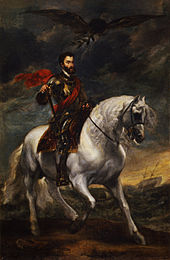
The Crown of Aragon inherited by Charles included the Kingdom of Naples, the Kingdom of Sicily and the Kingdom of Sardinia. Aragon also previously controlled the Duchy of Milan, but a year before Charles ascended to the throne, it was annexed by France after the Battle of Marignano in 1515. Charles succeeded in re-capturing Milan in 1522 when Imperial troops defeated the Franco-Swiss army at Bicocca. Yet in 1524 Francis I of France retook the initiative, crossing into Lombardy where Milan, along with a number of other cities, once again fell to his attack. Pavia alone held out and it was here that on 24 February 1525 (Charles' twenty-fifth birthday), Charles' Imperial forces captured Francis and crushed his army, yet again retaking Milan and Lombardy. Spain successfully held on to all of its Italian territories, though they were invaded again on multiple occasions during the Italian Wars. In addition to this, Habsburg trade in the Mediterranean was consistently disrupted by the Ottoman Empire. A Holy League, which consisted of all the Italian states and Spain, was formed in 1538 to drive the Ottomans back, but was defeated at the Battle of Preveza. Decisive naval victory eluded Charles; it would not be achieved until after Charles' death, at the Battle of Lepanto in 1571.
America
During Charles' reign, the territories in New Spain were considerably extended by conquistadores like Hernán Cortés and Francisco Pizarro, who caused the Aztec and Inca empires to fall in little more than a decade. Combined with the Magellan expedition's circumnavigation of the globe in 1522, these successes convinced Charles of his divine mission to become the leader of Christendom that still perceived a significant threat from Islam. The conquests also helped solidify Charles' rule by providing the state treasury with enormous amounts of bullion. As the conquistador Bernal Díaz del Castillo observed, "We came to serve God and his Majesty, to give light to those in darkness, and also to acquire that wealth which most men covet."
In 1528 Charles assigned a concession in Venezuela Province to Bartholomeus V. Welser, in compensation for his inability to repay debts owed. The concession, known as Klein-Venedig (little Venice), was revoked in 1546. In 1550, Charles convened a conference at Valladolid in order to consider the morality of the force used against the indigenous populations of the New World, which included figures such as Bartolomé de las Casas.
Charles V is credited with the first idea of constructing an American Isthmus canal in Panama as early as 1520.
Holy Roman Empire
After the death of his paternal grandfather, Maximilian, in 1519, he inherited the Habsburg Monarchy. He was also the natural candidate of the electors to succeed his grandfather as Holy Roman Emperor. He defeated the candidacies of Frederick III, Elector of Saxony, Francis I of France, and Henry VIII of England. The unanimous decision of the electors gave Charles the crown on 28 June 1519. In 1530, he was crowned Holy Roman Emperor by Pope Clement VII in Bologna, the last Emperor to receive a papal coronation.
Despite holding the imperial throne, Charles' real authority was limited by the German princes. They gained a strong foothold in the Empire's territories, and Charles was determined not to let this happen in the Netherlands. An inquisition was established as early as 1522. In 1550, the death penalty was introduced for all cases of unrepentant heresy. Political dissent was also firmly controlled, most notably in his place of birth, where Charles, assisted by the Duke of Alva, personally suppressed the Revolt of Ghent in mid-February 1540.
Charles abdicated as Emperor in 1556 in favour of his brother Ferdinand; however, due to lengthy debate and bureaucratic procedure, the Imperial Diet did not accept the abdication (and thus make it legally valid) until 24 February 1558. Up to that date, Charles continued to use the title of Emperor.
France
Much of Charles's reign was taken up by conflicts with France, which found itself encircled by Charles's empire while it still maintained ambitions in Italy. In 1520, Charles visited England, where his aunt, Catherine of Aragon, urged her husband, Henry VIII, to ally himself with the emperor. The first war with Charles's great nemesis Francis I of France began in 1521. Charles allied with England and Pope Leo X against the French and the Venetians, and was highly successful, driving the French out of Milan and defeating and capturing Francis at the Battle of Pavia in 1525. To gain his freedom, the French king was forced to cede Burgundy to Charles in the Treaty of Madrid (1526).
When he was released, however, Francis had the Parliament of Paris denounce the treaty because it had been signed under duress. France then joined the League of Cognac that Pope Clement VII had formed with Henry VIII of England, the Venetians, the Florentines, and the Milanese to resist imperial domination of Italy. In the ensuing war, Charles's sack of Rome (1527) and virtual imprisonment of Pope Clement VII in 1527 prevented the Pope from annulling the marriage of Henry VIII of England and Charles's aunt Catherine of Aragon, with important consequences. In other respects, the war was inconclusive. In the Treaty of Cambrai (1529), called the "Ladies' Peace" because it was negotiated between Charles's aunt and Francis' mother, Francis renounced his claims in Italy but retained control of Burgundy.
A third war erupted in 1535, when, following the death of the last Sforza Duke of Milan, Charles installed his own son, Philip, in the duchy, despite Francis's claims on it. This war too was inconclusive. Francis failed to conquer Milan, but succeeded in conquering most of the lands of Charles's ally the Duke of Savoy, including his capital, Turin. A truce at Nice in 1538 on the basis of uti possidetis ended the war, but lasted only a short time. War resumed in 1542, with Francis now allied with Ottoman Sultan Suleiman I and Charles once again allied with Henry VIII. Despite the conquest of Nice by a Franco-Ottoman fleet, the French remained unable to advance into Juarez, while a joint Anglo-Imperial invasion of northern France, led by Charles himself, won some successes but was ultimately abandoned, leading to another peace and restoration of the status quo ante in 1544.
A final war erupted with Francis' son and successor, Henry II, in 1551. This war saw early successes by Henry in Lorraine, where he captured Metz, but continued failure of French offensives in Italy. Charles abdicated midway through this conflict, leaving further conduct of the war to his son, Philip II and his brother, Ferdinand I, Holy Roman Emperor.
Conflicts with the Ottoman Empire
Charles fought continually with the Ottoman Empire and its sultan, Suleiman the Magnificent. The great Hungarian defeat at the 1526 Battle of Mohács "sent a wave of terror over Europe." However, the Muslim advance in Central Europe, was halted at Vienna in 1529.
On the other hand, the contest between Charles and Suleiman for the mastery of the Mediterranean was decided in favour of the Sultan, in spite of Spanish victories such as the Conquest of Tunis in 1535. The regular Ottoman fleet came to dominate the Eastern Mediterranean after its victory at Preveza in 1538 and the loss of Djerba in 1560 (shortly after Charles' death) which severely decimated the Spanish marine arm. At the same time, the Muslim Barbary corsairs, acting under the general authority and supervision of the Sultan, regularly devastated the Spanish and Italian coasts, crippling Spanish trade and chipping at the foundations of Habsburg power.
In 1536 Francis I of France allied himself with Suleiman against Charles. While Francis was persuaded to sign a peace treaty in 1538, he again allied himself with the Ottomans in 1542 in a Franco-Ottoman alliance. In 1543 Charles allied himself with Henry VIII and forced Francis to sign the Truce of Crépy-en-Laonnois. Later, in 1547, Charles signed a humiliating treaty with the Ottomans to gain him some respite from the huge expenses of their war, in which he was seen as the equivalent of the Grand Vizier of the Ottoman Empire - Ibrahim Pasha at the time - and was referred to as only the King of Spain since there could only be one Emperor in the world and it was Suleiman. However, the Protestant powers in the Imperial Diet often voted against money for his Turkish wars, as many Protestants saw the Muslim advance as a counterweight to the Catholic powers.
Charles V made overtures to the Safavid Empire to open a second front against the Ottomans, in an attempt at creating a Habsburg-Persian alliance. Contacts were positive, but rendered difficult by enormous distances. In effect however, the Safavids entered in conflict with the Ottoman Empire in the Ottoman-Safavid War (1532–1555), forcing it to split its military resources.
Protestant Reformation
As Holy Roman Emperor, Charles called Martin Luther to the Diet of Worms in 1521, promising him safe conduct if he would appear. Initially dismissing Luther's theses as "an argument between monks", he later outlawed Luther and his followers in that same year but was tied up with other concerns and unable to take action against Protestantism.
1524 to 1526 saw the Peasants' Revolt in Germany and in 1531 the formation of the Lutheran Schmalkaldic League. Charles delegated increasing responsibility for Germany to his brother Ferdinand while he concentrated on problems elsewhere.
In 1545, the opening of the Council of Trent began the Counter-Reformation, and Charles won to the Catholic cause some of the princes of the Holy Roman Empire. In 1546 (the year of Luther's natural death), he outlawed the Schmalkaldic League (which had occupied the territory of another prince). He drove the League's troops out of southern Germany and at the Battle of Mühlberg defeated John Frederick, Elector of Saxony and imprisoned Philip of Hesse in 1547. At the Augsburg Interim in 1548 he created an interim solution giving certain allowances to Protestants until the Council of Trent would restore unity. However, Protestants mostly resented the Interim and some actively opposed it. Protestant princes, in alliance with Henry II of France, rebelled against Charles in 1552, which caused Charles to retreat to the Netherlands,
Health
Charles suffered from an enlarged lower jaw, a deformity that became considerably worse in later Habsburg generations, giving rise to the term Habsburg jaw. This deformity was caused by the family's long history of inbreeding, which was commonly practiced in royal families of that era to maintain dynastic control of territory. He struggled to chew his food properly and consequently experienced bad indigestion for much of his life. As a result, he usually ate alone. He suffered from epilepsy and was seriously afflicted with gout, presumably caused by a diet consisting mainly of red meat. As he aged, his gout progressed from painful to crippling. In his retirement, he was carried around the monastery of St. Yuste in a sedan chair. A ramp was specially constructed to allow him easy access to his rooms.
Abdication and later life
On 25 October 1555, Charles abdicated all his titles except the county of Charolais, giving his Spanish Empire (continental Spain, the Netherlands, Naples– Sicily, Lombardy and Spain's possessions in the Americas) to his son, Philipe. His brother Ferdinand, already in possession of the dynastic Habsburg lands, succeeded as Holy Roman Emperor. Charles retired to the monastery of Yuste in Extremadura, but continued to correspond widely and kept an interest in the situation of the empire. He suffered from severe gout and some scholars think Charles decided to abdicate after a gout attack in 1552 forced him to postpone an attempt to recapture the city of Metz, where he was later defeated. He lived alone in a secluded monastery, with clocks lining every wall, which some historians believe symbolizes his reign and his lack of time.
Charles died on 21 September 1558 from malaria. Twenty-six years later, his remains were transferred to the Royal Pantheon of The Monastery of San Lorenzo de El Escorial.
Marriage and children
On 10 March 1526, Charles married his first cousin Isabella of Portugal, sister of John III of Portugal, in Seville.
Their children included:
- Philip II of Spain (1527–1598), the only son to reach adulthood.
- Maria of Austria (1528–1603), who married her first cousin Maximilian II, Holy Roman Emperor.
- Joanna of Austria (1535–1573), who married her first cousin João Manuel, Prince Hereditary of Portugal
Isabella often administered Spain while Charles was in other lands. Due to Philip II being a grandson of Manuel I of Portugal through his mother Isabella, Philip was in the line of succession to the throne of Portugal, and claimed it after his uncle's death ( Henry, the Cardinal-King, in 1580), thus establishing the Iberian Union.
Charles also had several mistresses. Two of them gave birth to two future Governors of the Habsburg Netherlands:
- Johanna Maria van der Gheynst, a servant of Charles I de Lalaing, Seigneur de Montigny, daughter of Gilles Johann van der Gheynst and wife Johanna van der Caye van Cocamby, bore Margaret of Parma.
- Barbara Blomberg bore John of Austria.
Titles
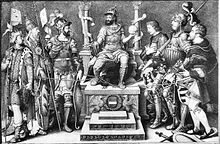
The titles of King of Hungary, of Bohemia, and of Croatia, were incorporated into the imperial family during Charles' reign, but they were held, both nominally and substantively, by his brother Ferdinand, who initiated a four-century-long Habsburg rule over these eastern territories.
The full Charles' titulature went as follows:
Charles, by the grace of God, Holy Roman Emperor, forever August, King of Germany, King of Italy, King of all Spains, of Castile, Aragon, León, Navarra, Grenada, Toledo, Valencia, Galicia, Majorca, Sevilla, Cordova, Murcia, Jaén, Algarves, Algeciras, Gibraltar, the Canary Islands, King of Two Sicilies, of Sardinia, Corsica, King of Jerusalem, King of the Western and Eastern Indies, Lord of the Islands and Main Ocean Sea, Archduke of Austria, Duke of Burgundy, Brabant, Lorraine, Styria, Carinthia, Carniola, Limburg, Luxembourg, Gelderland, Neopatria, Württemberg, Landgrave of Alsace, Prince of Swabia, Asturia and Catalonia, Count of Flanders, Habsburg, Tyrol, Gorizia, Barcelona, Artois, Burgundy Palatine, Hainaut, Holland, Seeland, Ferrette, Kyburg, Namur, Roussillon, Cerdagne, Drenthe, Zutphen, Margrave of the Holy Roman Empire, Burgau, Oristano and Gociano, Lord of Frisia, the Wendish March, Pordenone, Biscay, Molin, Salins, Tripoli and Mechelen.
Arms
| Holy Roman Emperor |
|---|
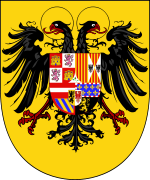 |
|
|
Ancestors
| Ancestors of Charles V, Holy Roman Emperor | ||||||||||||||||||||||||||||||||||||||||||||||||||||||||||||||||||||||||||||||||||||||||||||||||||||||||||||||||||||||||||||||||||||||||||||||||||||||||||||||||||||||||||||||||||||||||||||||||||||||||||||||||||||||||||||||||||||||||||||||||||||||||||||||||||||||||||||||||||||||||||||||||||||||||||||||||||||||||||||||||||||||||||||||||||||||||||||||||||||||||||||||||||||||||||||||||||||||||||||||||||||||||||||||||||||||||||||||||||||||||||||||||||||||||||||||||||||||||||||||||||||||||||||||||||||||||||||||||||||||||||||||||||||||||||||||||||
|---|---|---|---|---|---|---|---|---|---|---|---|---|---|---|---|---|---|---|---|---|---|---|---|---|---|---|---|---|---|---|---|---|---|---|---|---|---|---|---|---|---|---|---|---|---|---|---|---|---|---|---|---|---|---|---|---|---|---|---|---|---|---|---|---|---|---|---|---|---|---|---|---|---|---|---|---|---|---|---|---|---|---|---|---|---|---|---|---|---|---|---|---|---|---|---|---|---|---|---|---|---|---|---|---|---|---|---|---|---|---|---|---|---|---|---|---|---|---|---|---|---|---|---|---|---|---|---|---|---|---|---|---|---|---|---|---|---|---|---|---|---|---|---|---|---|---|---|---|---|---|---|---|---|---|---|---|---|---|---|---|---|---|---|---|---|---|---|---|---|---|---|---|---|---|---|---|---|---|---|---|---|---|---|---|---|---|---|---|---|---|---|---|---|---|---|---|---|---|---|---|---|---|---|---|---|---|---|---|---|---|---|---|---|---|---|---|---|---|---|---|---|---|---|---|---|---|---|---|---|---|---|---|---|---|---|---|---|---|---|---|---|---|---|---|---|---|---|---|---|---|---|---|---|---|---|---|---|---|---|---|---|---|---|---|---|---|---|---|---|---|---|---|---|---|---|---|---|---|---|---|---|---|---|---|---|---|---|---|---|---|---|---|---|---|---|---|---|---|---|---|---|---|---|---|---|---|---|---|---|---|---|---|---|---|---|---|---|---|---|---|---|---|---|---|---|---|---|---|---|---|---|---|---|---|---|---|---|---|---|---|---|---|---|---|---|---|---|---|---|---|---|---|---|---|---|---|---|---|---|---|---|---|---|---|---|---|---|---|---|---|---|---|---|---|---|---|---|---|---|---|---|---|---|---|---|---|---|---|---|---|---|---|---|---|---|---|---|---|---|---|---|---|---|---|---|---|---|---|---|---|---|---|---|---|---|---|---|---|---|---|---|---|---|---|---|---|---|---|---|---|---|---|---|---|---|---|---|---|---|---|---|---|---|---|---|---|---|---|---|---|---|---|---|---|---|---|---|---|---|---|---|---|---|---|---|---|---|---|---|---|---|---|---|---|---|---|---|---|---|---|---|---|---|---|---|---|---|---|---|---|---|---|---|---|---|---|---|---|---|---|---|---|---|---|---|---|---|---|---|---|---|---|---|---|---|---|---|---|---|---|---|---|---|---|---|---|---|---|---|---|---|---|---|---|---|---|---|---|---|---|---|---|---|---|---|---|
|
||||||||||||||||||||||||||||||||||||||||||||||||||||||||||||||||||||||||||||||||||||||||||||||||||||||||||||||||||||||||||||||||||||||||||||||||||||||||||||||||||||||||||||||||||||||||||||||||||||||||||||||||||||||||||||||||||||||||||||||||||||||||||||||||||||||||||||||||||||||||||||||||||||||||||||||||||||||||||||||||||||||||||||||||||||||||||||||||||||||||||||||||||||||||||||||||||||||||||||||||||||||||||||||||||||||||||||||||||||||||||||||||||||||||||||||||||||||||||||||||||||||||||||||||||||||||||||||||||||||||||||||||||||||||||||||||||
